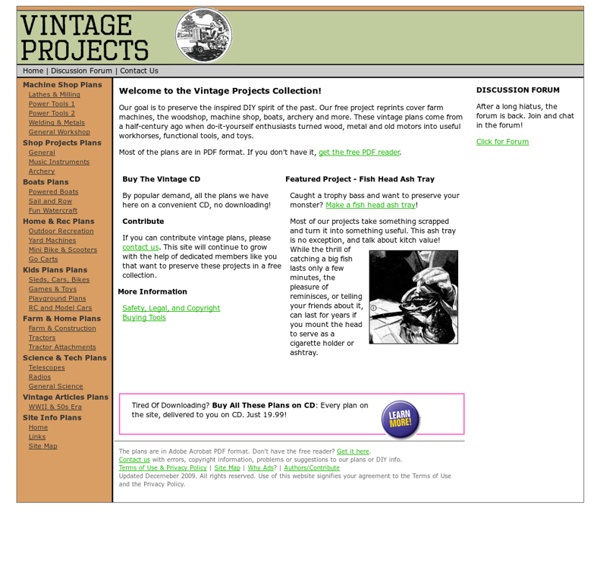



http://www.vintageprojects.com/
Related: Project Based Web SitesHow to Make a Pinwheel. As the summer comes, children like to play outside while I try to be indoors like a rat. A pinwheel is a perfect toy, and easy, for children that likes to play outside. Here is how to build one. Before starting this project, please read the disclaimer located in the main menu. Concepts And Designs No More Woof Breaks Interspecies Communication Barriers How many videos of animals “talking” have you watched on YouTube? Don’t you wish those were real? PVC Pedal Launcher Thanks for the awesome plans and such a great design. Here's some photos showing my version of the launcher. My changes: 1. PVC rails are 5 ft. 2. legs are cut to 44" wide. (Still accommodates a large wingspan and various positions for the rails) 3. installed a return spring on the foot pedal to avoid accidental launches.
Jim Walker Military Launcher for Folding Wing A-J Army Interceptor <meta name="description" content="The Jim Walker military catapult launcher used in WWII for the folding wing Army Interceptor" /> When World War II broke out in Europe, Jim Walker began to think of how to use different types of model airplanes to aid in the war effort. At that time he was thinking of large Radio Controlled planes, never dreaming that there was anything in the toy field that would meet army needs. One day in Texas, a colonel who had bought dozens of the toy gliders for his own children, walked into a variety store and picked up a handful of American Junior Aircraft's little Army Interceptor folding wing gliders. "Heck," he said, "these are the babies we want." Consequently an order for 500 of the planes came from the instructor's training headquarters in Texas. This was followed shortly by an order for 1,000 and then one for 5,000.
Folding Wing Glider Patent Papers by Jim Walker Here are the original patent application papers Jim Walker filed for the folding wing glider concept. This was the model airplane that came to be known as the Army Interceptor. As a historical document, it is offered here for you to see. Please note that the lawyers insisted on the use of "toy" glider and not "model" glider that Jim Walker would have preffered. Nevilles E. Projects As of July 1, 2013 ThinkQuest has been discontinued. We would like to thank everyone for being a part of the ThinkQuest global community: Students - For your limitless creativity and innovation, which inspires us all. Teachers - For your passion in guiding students on their quest. Partners - For your unwavering support and evangelism.
How to Can, Freeze, Dry and Preserve Any Fruit or Vegetable at Home Home canning, freezing and preserving, whether it is jam, salsa, applesauce, apple butter, pickles or whatever, is easy; with these simple, fully illustrated directions with detailed tips and tricks. Save money, eat healthier, with no additives or chemicals... and with much better taste! This page provides the links to our illustrated recipes and canning* directions - so easy ANYONE can do it, along with a multitude of other recipes, guides and canning instructions. For safety, these recipes closely follow the USDA recipes, Ball Blue Book and/or those provided by major university extension services. Whenever possible, instructions also are provided to allow you to choose the options that are important to you; such as types of cooking equipment or choices in sweeteners: honey, Stevia (in a prepared form like Truvia, it measures same as sugar; if you use another form, you'll need do your own conversion) - or Splenda, if you prefer, , Stevia, fruit juice or sugar. United States
Halliburton GEAR Project Based Learning Lesson Plans Research shows a decline in student involvement in STEM related education and careers. The media and political arenas have brought to light that U.S. students are falling behind those in other countries, especially in math and science. In order to help solve this problem, education agencies are looking towards Project Based Learning (PBL) and 21st Century Skills in hopes of generating students interest not only in STEM but to improve student skills in critical thinking and problem solving. On this page, teachers will find resources and lesson plans for a PBL activity that combines LEGO robotics and the 2012 GEAR “Power Up” competition challenges. Halliburton graciously sponsored the 2012 GEAR competition and provided the focus of robotics in the energy fields. The PBL activities focus on implementing robotics into a variety of energy simulations centered in a variety of fields – petroleum, solar, wind, biofuels, and hydroelectricity.
Spark, Bang, Buzz and Other Good Stuff. MAKE HOMEMADE SCIENCE TOYS AND PROJECTS AMA Glider - Home Make It and Love It